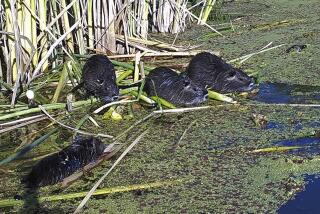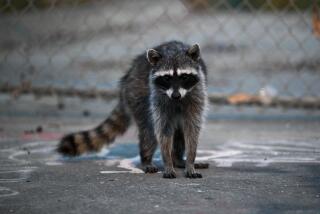Chatsworth Shelter Would Like to Give Rare Guest a Permanent Home--and Job
- Share via
The callers didn’t know what it was. They just knew they wanted it gone.
“It was a kind of strange description,” said Lt. Richard Felosky of the West Valley Animal Shelter in Chatsworth. “Long ringed tail like a raccoon, body like a possum, only smaller, kind of like a weasel, only bigger. They saw it running around their building. Could we get it out of there?”
Felosky knows what to expect when a caller reports what appears to be an atomic mutant rat: It’s just an opossum.
But this could have been anything. His officers put some meat outside the Rocketdyne plant in Canoga Park and the next day they had the rarest catch in Felosky’s 25 years in animal control: Bassariscus astutus, commonly known as the ring-tail cat--although a cat it is not.
A member of the raccoon family, the ring-tail is indigenous from Oregon to the south end of Mexico, but it almost never shows up in urban settings.
Although Felosky ships out a couple of dozen raccoons and opossums to the wild each week, he had seen only one other ring-tail in his career. That was 15 years ago.
He looked in his National Geographic Book of Mammals and learned that “during the gold rush in the American West, prospectors often kept ring-tails in their camps to catch rats and mice.”
Maybe, he thought, this foot-long creature with the even longer ringed tail was the answer to the West Valley shelter’s rat problem. Because of the abundant rain and all the animal food kept at the shelter, hundreds of rats have moved in.
The staff trapped about 100 in the food storage room in a month. But then the rats learned to avoid the traps and went to other rooms.
“They’re running all over the offices now,” Felosky said. “I think I’m going to have a clerical staff that’s going to revolt.”
Felosky said he will keep the ring-tail in captivity for the required period in the unlikely event it has an owner who wants to claim it. Then, if the animal shows any sign of bonding with the staff, he will consider turning it loose around the shelter, rather than airlifting it to the high country as he would do with other wild animals.
“This little guy, according to the literature, is made for this type of work,” he said. “That’s how he makes his living. It would be a boon to us if he is that type of character.”
For now, the little guy, yet to be named or even categorized by sex, lives in a cardboard box inside a cage in the shelter’s quarantine room, enjoying meals of liverwurst and smoked fish and--what else would a captive rare species do?--getting into the middle of a controversy.
“Oh God. That’s awful,” said Lynn Barkley, collections manager for the bird and mammal section of the Los Angeles County Museum of Natural History, when told of the high-fat diet. “They’re giving it such absurd things. They need to be giving it raw vegetables and fruit . . . some meat and chicken. Even possums don’t do well on high fat diet.”
Barkley also was not pleased to learn of Felosky’s plan to draft the ring-tail into rodent patrol.
“He’d be much more successful letting a cat do it,” Barkley said. This animal eats native mice, not the European rats that infest urban dwellings, she said.
“I can’t see it running around concrete catching food it isn’t accustomed to. I think the animal is doomed.”
What Is a Ring-Tail?
* Length: Head and body, 12 to 20 inches. The tail is another 13 to 20 inches.
* Weight: 2 1/2 to 3 pounds.
* Habitat and range: Deserts, canyons and forests from Oregon to Mexico.
* Food: Rodents, insects, birds, fruit and plants.
* Life span: 10 years in the wild.
* Reproduction: One to four young after a two-month pregnancy.
* Order: Carnivora.
Source: National Geographic Book of Mammals
More to Read
Sign up for Essential California
The most important California stories and recommendations in your inbox every morning.
You may occasionally receive promotional content from the Los Angeles Times.











